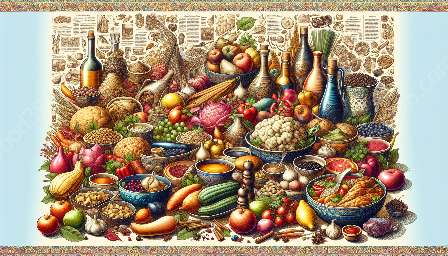Gender roles in food preparation and consumption have played a pivotal role in shaping the culture and traditions of ancient societies. The interplay of gender, food, and societal norms provides fascinating insights into the dynamics of ancient civilizations. In this comprehensive exploration, we will delve into the multifaceted aspects of gender roles in relation to food, uncovering the intricate connections between ancient food traditions and rituals and the origin and evolution of food culture.
Ancient Food Traditions and Rituals:
Ancient societies were deeply rooted in food traditions and rituals, often influenced by cultural and religious beliefs. The preparation and consumption of food were integral parts of ceremonial practices and social gatherings, serving as a means of reinforcing communal bonds and expressing cultural identity.
- Ceremonial Offerings: In many ancient societies, food preparation was an essential part of religious rituals and offerings. Gender roles often dictated specific responsibilities for the preparation of ceremonial meals, with women frequently leading the culinary efforts in sacred ceremonies.
- Feasting and Festivals: Festive occasions and communal feasts were significant events in ancient societies, where the division of labor in food preparation often reflected gender-specific roles. Men and women played distinct roles in food procurement, cooking, and serving during these communal gatherings, perpetuating traditional gender norms.
Origin and Evolution of Food Culture:
The origin of food culture in ancient societies was intricately linked to the division of labor and societal structures. Gender roles in food preparation and consumption were shaped by a complex interplay of cultural, economic, and environmental factors, laying the foundation for the evolution of food culture.
- Hunting and Gathering: In ancient hunter-gatherer societies, gender roles in food procurement were often delineated, with men predominantly tasked with hunting and women responsible for gathering plant-based food sources. These early gender-based divisions in food acquisition set the stage for subsequent food culture development.
- Agricultural Practices: With the advent of agricultural societies, gender roles in food production became more defined, as men typically engaged in farming and animal husbandry while women managed food preservation and processing. These roles were deeply embedded in the cultural fabric and significantly influenced the culinary traditions of ancient civilizations.
Exploring Gender Roles in Food Preparation:
The allocation of food-related tasks based on gender roles was a widespread practice in ancient societies, with distinct responsibilities for men and women in food preparation. These gender-specific roles not only contributed to the efficiency of food production but also served as a reflection of societal norms and values.
- Culinary Expertise: Women in many ancient societies held extensive knowledge of food preparation techniques, culinary traditions, and medicinal uses of various ingredients. Their expertise in food preparation was often passed down through generations, contributing to the preservation of culinary heritage.
- Ritualistic Cooking: The preparation of ritualistic meals and offerings often showcased the intricate culinary skills of women, highlighting their integral role in upholding cultural and religious traditions. Men, on the other hand, played significant roles in procuring specific ingredients and resources essential for these ceremonial practices.
Gender Roles in Food Consumption:
The consumption of food in ancient societies was also subject to gender-based customs and etiquettes, reflecting the societal dynamics surrounding food consumption and communal dining.
- Communal Dining Etiquettes: Gender roles often extended to communal dining practices, with prescribed norms dictating seating arrangements, serving protocols, and the types of food consumed by men and women. These customs served as a reflection of social hierarchies and power dynamics within ancient communities.
- Cultural Significance: Certain types of foods were associated with gender-specific cultural significance, with rituals and traditions attributing symbolic meanings to food items based on gender. These symbolic associations enriched the cultural tapestry of ancient food traditions, contributing to the formation of distinctive food cultures.
Through this nuanced exploration of gender roles in food preparation and consumption in ancient societies, we gain valuable insights into the intricate interplay of gender dynamics within culinary traditions, shaping the origin and evolution of food culture across diverse ancient civilizations.


